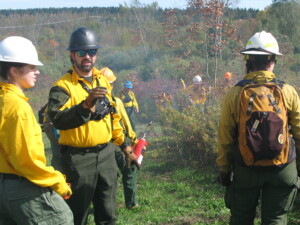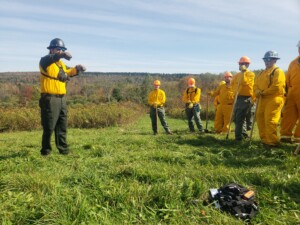Climate change requires re-evaluation of forest management techniques.
As smoke from Canadian wildfires spread across U.S. skies this past summer, the realities of climate change also moved closer to home.
Without proper forest management, such smoke-filled skies – which created unhealthy air conditions and limited outdoor activities – could become the new normal.
“We should be prepared to deal with this more often,” said Dr. Andrew Vander Yacht, assistant professor of applied forest and fire ecology in ESF’s Department of Sustainable Resources Management. This is one of the messages he shared when tapped as an expert resource by numerous media outlets to explain the causes and controls of wildfires.


Vander Yacht said climate change – hotter and drier conditions – and forest management decisions are both partially responsible.
“With climate change and a legacy of our forest management decisions, we’re in a situation where we’re seeing the results of that on the landscape,” he said. In 2021, those results were more than 4,000 deaths, over 7 million acres of land burned, and $16 billion in property loss, according to the U.S. Fire Administration.
Vander Yacht explained that people have gone to the extreme to suppress fires, even though they are a natural part of the forest life cycle. This has led to an accumulation of fuels – such as dead trees and dry grass – that are not in line with what would have been present historically.
Active forest management, however, reduces fuel loads and can improve forest health. “When we reduce the fuel loads, we’ve found emissions during a wildfire are two to three times less and that will be critical in a changing climate,” said Vander Yacht.

In New York state, wildfires do occur, but places like the Adirondacks – with its wetter canopy-covered forests – limit their frequency and severity. However, with consistently drier, warmer conditions, that could change.
Vander Yacht suggested looking ahead may be more beneficial than looking back, especially in the Northeast. While the region has not typically experienced major fire events in the past century, that doesn’t mean it hasn’t happened, or couldn’t happen again.
The combination of extensive droughts and rising temperatures have the potential to dry forest fuels, increasing the likelihood and severity of wildfires.
And that’s where forest management and carefully managed fire come into play.
Restoring Ecological Balance
Vander Yacht would like to see prescribed burns used more often in forest management in the Northeast. These are intentional fires used to reduce the fuel load and rejuvenate the landscape to benefit species that need open space to thrive.
“We don’t need to fearmonger fire issues to the forefront to make them interesting,” he said. “There’s a certain portion of the biodiversity of the Northeast that is disturbance-dependent and relies on fire to maintain its position on the landscape.”
Fire isn’t inherently good or bad. It’s a natural force that is instrumental in creating and maintaining habitat for grassland birds and endangered species such as the Karner blue butterfly of the Albany pine bush. But grasslands require an intensive amount of management that is maintained through disturbance. Even the American chestnut tree may benefit from the open landscape a prescribed burn can create.
“We know a little bit about where the American chestnut trees occurred on the landscape naturally,” said Vander Yacht, “and that was in association with frequently burned sites. We might be able to use fire to make sure we can establish those new chestnut seedlings that we have to restore the American chestnut to the eastern United States.”
A century without fires in the Northeast has heightened perceptions of inflammability and supported claims of historical fire absence – limiting fire management and research in the region. However, Vander Yacht believes those attitudes are changing.



From Classroom to the Field: ESF’s First Fire and Ecology Management Course
This fall, Vander Yacht taught a Fire Ecology and Management course, the first in the College’s history. Because ESF alumni work in all areas of the country, Vander Yacht wants to provide students with the tools and knowledge they’ll need if they pursue careers where wildfire is a non-ignorable issue in forest management.
To do that, Vander Yacht took his class to Heiberg Memorial Forest in Tully, NY, where they learned the steps involved in implementing a prescribed burn. The 30 students spent the first half of the semester preparing for the fieldwork.
“First and foremost, the objective is to teach our students how to properly, safely, and effectively use fire as a land management tool,” said Vander Yacht.
The steps in the process included a 16-page burn plan written by Vander Yacht and his teaching assistant, Maria Loughran. This plan was approved by the New York State Department of Environmental Conservation (DEC) and involved outlining steps to coordinate actions and communication with 911 dispatch and local fire departments, and tracking weather conditions.

“Preparing for the burn has been pretty rigorous,” said Allyson Henson, a senior forest resources management major. “We had about seven weeks in class learning about the logistics of fire, how it behaves and then we get to see it unfold.”

On-site, students received instructions from Vander Yacht and Loughran – a master’s student in Vander Yacht’s Applied Forest and Fire Ecology Lab. Digging suppression trenches, filling and igniting the drip torches, monitoring the fire, and reporting the data were all covered by the pair before flames were ignited.
Some of the collected data will be of interest to researchers on the American Chestnut Research and Restoration Project. As they await federal approval on the Darling 58 – the first blight-tolerant transgenic chestnut that could help usher in a rebirth of the iconic species – they’re researching how fire might be used to help re-establish the trees and their habitat.
Project Director Dr. Andrew Newhouse ‘05 was onsite for the burn to observe how the fire might impact non-transgenic American chestnut seedlings that had been planted in the burn zone.
“The idea is that we’re learning how they respond to fires,” he said. “Some trees respond very differently. On some, even if the leaves and some of the surface burns, they can re-sprout and become established better than other species.”
Oaks, for example, respond well to fire while maples don’t.
“Fire can be an important tool for people trying to manage a woodland to promote oak or other high-value hardwoods,” Newhouse explained. “Chestnuts basically haven’t been around for the last hundred-plus years, so we don’t know for sure how they’ll respond, but we suspect they will respond well to fire like oaks. We want to find out how prescribed fire might be used to promote the establishment of American chestnut in restoration settings.”
Vander Yacht is pleased with his first fire ecology class, noting several students already had wildland firefighter certification, have been out west on wildfires, and participated in prescribed fire management.
“I think our students recognize that fire is a global issue that they will need to consider in the management of natural resources. I want people to know they don’t have to be scared of fire. It is something that can be managed and even useful to have on the landscape.”


